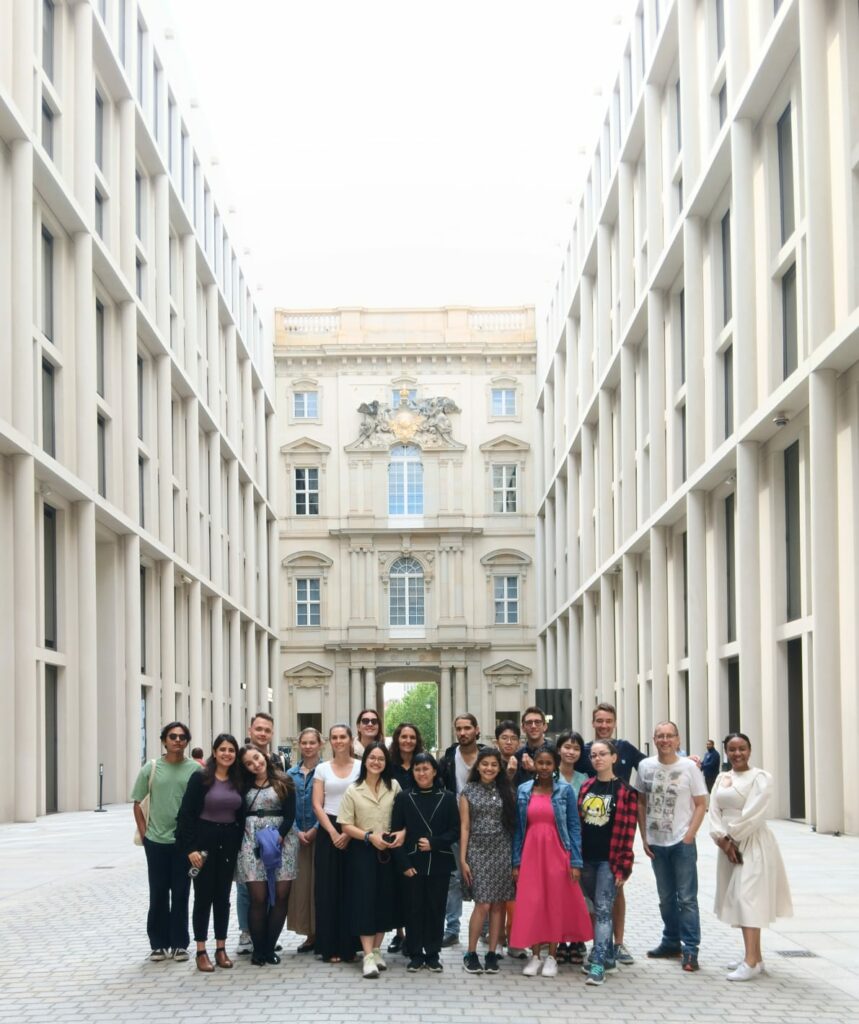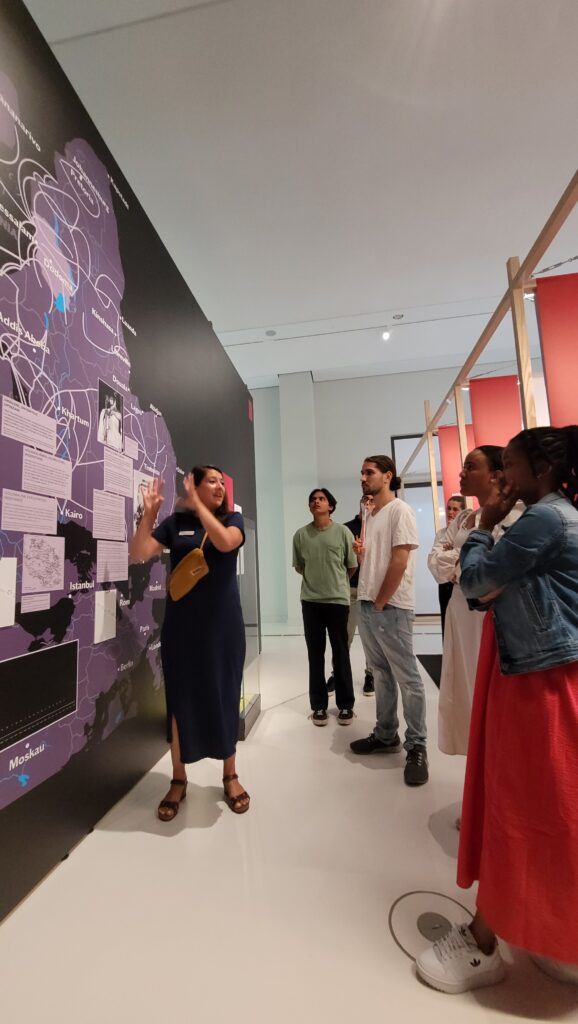By Gys Du Toit and Lukas Hügle
During a transcultural student research trip in July, the Transcultural Student Research Group (TSRG 2023) visited the Humboldt Forum, one of Berlin’s newest landmarks. The place is more than a museum: it is a foundation, a partnership, and a space where global and local stakeholders meet, explore, and discover. Some of the collective impressions experienced are shared here.
Entering the Humboldt Forum, the group was struck by its charm of historic Baroque, yet fresh appearance. An entertaining guide, an American with German and Egyptian roots, brought a fresh perspective to interpreting time and space. In terms of the historical background, some buildings in the area were reconstructed after the reunification of Germany in 1990, whereas many buildings were built much earlier. The Humboldt Forum, also called the “Buckingham Palace of Germany” was modelled on the location’s original building demolished in 1950, which was the German imperial family’s residence after the First World War.

The TSRG 2023 visit to the Humboldt Forum.
The group watched a creative video display about the history of the building, with historical events over the past 800 years from its early origins as a monastery up to today. This is an impressive investment in Berlin’s urban space, serving as an edited version of the past, considering that the “Palace of the Republic” of 1973-2008 was effectively erased from history and replaced with a building modelled on the glorious history of Germany’s architecture and pride with a re-interpretation associated with its history as a royal residence. Surprisingly, the facade was paid for by private donors, EUR 80 million in addition to the EUR 644 million construction cost. The context of funding associated with the building’s architectural design can be closely linked to its historical social significance and future use. Historical influences shaped decisions related to the construction of the building which reflects contrasts within the unitary architectural design choice, between modernity, and classical architectural urban elements with reconstructed façades and entrances, adding to its grandeur.
The idea behind the buildings’ design is that “form follows function”, meaning that if you have a use for a thing, such as a building, this use dictates how it will be shaped. The goal of the palace, being a big and fancy house, was to be comfortable and warm in winter. This contrasts with its current use where historical artifacts are preserved, which requires cooler and darker conditions for preservation. The building opened during the COVID-19 pandemic in 2020 with phased openings that continued until 2022, which provided a challenge to manage the organisation’s development and accessibility. The collection includes stakeholders from global communities in countries representing the various collections. Paradoxes of the building include perceptions of visitors, who may not understand the interior, just by looking at the exterior. The guide stressed the tension that exists between German modesty and the need to provide stronger visual cues and marketing to match the quality of the exhibitions. An example cited was that many people will know where the Mona Lisa is located, whereas few people know where Nefertiti is, impacting visitor numbers to Berlin.
A tour of the Humboldt Forum included a beautiful panoramic view of the city of Berlin from its roof. The different views of the city were explained, and Berlin was described as the “best party city in the world” by the tour guide. For example, the Axel Springer headquarters skyscraper right next to the Berlin Wall could be seen. A memorable fact provided in the tour is that Berlin occupies an area six times that of Paris. As part of the tour, lots of videos and pictures were shown, as “people don’t read”, as the tour guide claimed. It was highlighted that the Humboldt Forum is an institution almost without objects. Therefore, easy, and crucial options are chosen as part of the visitor experience at the forum, which is in contrast to curation that aims to provoke reflection and dialogue.

Panoramic view from the roof of the Humboldt Forum provides another critical perspective.
Accessibility was one of the challenges the management team took on, transforming the building into a model for differently able people with mobility, visual, and audio considerations. Exhibitions provoke a lot of debate, considering not only consent but also considerations of a post-colonial world where a lot of reconciliation and alignment is required to address injustices of the past.
A provocative collection, called “Exhibiting. Omissions”, shed some light on managing objects acquired during colonial rule. The Tanzanian collection of cultural objects includes 10,000 items, 90% were appropriated during colonial times. Consent to exhibit these items linked to colonial atrocities posed a challenge for the curatorial team, who involved two people from Tanzania and collaboration with local communities to support decisions to exhibit the cultural artifacts. Only items with informed consent from communities where the objects originated from are displayed. A critical companion input to the representation is the creation of discomfort, ensuring that the exhibition generates emotion and raises questions.

“Exhibiting. Omissions” – Challenging Curator and Visitor
The representatives of the Humboldt Forum have shown that skilful behaviour is required to work with the complexities of stakeholder requirements. A diplomatic meandering is required to manage the four main partners of the forum. The overall strategic direction is informed by the heads of institutions appointed through a political process, representing German national identity through political representation. A governmental stratified system of seniority of appointments is often in contrast to diversity and inclusion, being critical to represent the realities of the exhibitions, which are opportunities for further development to translate activist positions to processes in the institution to make progress on post-colonial and de-colonial futures. This leaves the forum as the playground for employees to open the building to various standpoints with international cultural baggage through a collaborative process. Staff training includes the expansion of people’s vocabulary to be more comfortable and represented in institutions. The global-local tension is balanced through facilitation, using the space to translate into administrative, cultural, and capability-building practices such as internal workshops to enable people to navigate complexity.
Learning about the Humboldt Forum turned out to be an immensely enlightening experience for the transcultural caravan group. As it is a dynamic partner, the Humboldt Forum is worth a visit as it can facilitate transformation in society through collaboration to reconstruct and navigate the future.
Special thanks to Erik Heermann, Tarek Ibrahim, Maike Schimanowski, and Amel Ouaissavery and staff of the Humboldt Forum who hosted the TSRG 2023.
